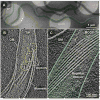Spirochetal motility and chemotaxis in the natural enzootic cycle and development of Lyme disease
- PMID: 26519910
- PMCID: PMC4688064
- DOI: 10.1016/j.mib.2015.09.006
Spirochetal motility and chemotaxis in the natural enzootic cycle and development of Lyme disease
Abstract
Two-thirds of all bacterial genomes sequenced to-date possess an organelle for locomotion, referred to as flagella, periplasmic flagella or type IV pili. These genomes may also contain a chemotaxis-signaling system which governs flagellar rotation, thus leading a coordinated function for motility. Motility and chemotaxis are often crucial for infection or disease process caused by pathogenic bacteria. Although motility-associated genes are well-characterized in some organisms, the highly orchestrated synthesis, regulation, and assembly of periplasmic flagella in spirochetes are just being delineated. Recent advances were fostered by development of unique genetic manipulations in spirochetes coupled with cutting-edge imaging techniques. These contemporary advances in understanding the role of spirochetal motility and chemotaxis in host persistence and disease development are highlighted in this review.
Copyright © 2015 Elsevier Ltd. All rights reserved.
Figures




 ) represent tick or host blood-borne noxious factors that clear non-motile spirochetes from the tick midgut. BM, basement membrane.
) represent tick or host blood-borne noxious factors that clear non-motile spirochetes from the tick midgut. BM, basement membrane.Similar articles
-
Motor rotation is essential for the formation of the periplasmic flagellar ribbon, cellular morphology, and Borrelia burgdorferi persistence within Ixodes scapularis tick and murine hosts.Infect Immun. 2015 May;83(5):1765-77. doi: 10.1128/IAI.03097-14. Epub 2015 Feb 17. Infect Immun. 2015. PMID: 25690096 Free PMC article.
-
Genetics of motility and chemotaxis of a fascinating group of bacteria: the spirochetes.Annu Rev Genet. 2002;36:47-73. doi: 10.1146/annurev.genet.36.041602.134359. Epub 2002 Jun 11. Annu Rev Genet. 2002. PMID: 12429686 Review.
-
The flagellar cytoskeleton of the spirochetes.J Mol Microbiol Biotechnol. 2006;11(3-5):221-7. doi: 10.1159/000094056. J Mol Microbiol Biotechnol. 2006. PMID: 16983197 Review.
-
Borrelia burgdorferi CheY2 Is Dispensable for Chemotaxis or Motility but Crucial for the Infectious Life Cycle of the Spirochete.Infect Immun. 2016 Dec 29;85(1):e00264-16. doi: 10.1128/IAI.00264-16. Print 2017 Jan. Infect Immun. 2016. PMID: 27799336 Free PMC article.
-
Mutations in the Borrelia burgdorferi Flagellar Type III Secretion System Genes fliH and fliI Profoundly Affect Spirochete Flagellar Assembly, Morphology, Motility, Structure, and Cell Division.mBio. 2015 May 12;6(3):e00579-15. doi: 10.1128/mBio.00579-15. mBio. 2015. PMID: 25968649 Free PMC article.
Cited by
-
FliL ring enhances the function of periplasmic flagella.Proc Natl Acad Sci U S A. 2022 Mar 15;119(11):e2117245119. doi: 10.1073/pnas.2117245119. Epub 2022 Mar 7. Proc Natl Acad Sci U S A. 2022. PMID: 35254893 Free PMC article.
-
FlhF regulates the number and configuration of periplasmic flagella in Borrelia burgdorferi.Mol Microbiol. 2020 Jun;113(6):1122-1139. doi: 10.1111/mmi.14482. Epub 2020 Feb 21. Mol Microbiol. 2020. PMID: 32039533 Free PMC article.
-
Borrelia burgdorferi CheD Promotes Various Functions in Chemotaxis and the Pathogenic Life Cycle of the Spirochete.Infect Immun. 2016 May 24;84(6):1743-1752. doi: 10.1128/IAI.01347-15. Print 2016 Jun. Infect Immun. 2016. PMID: 27021244 Free PMC article.
-
A tetratricopeptide repeat domain protein has profound effects on assembly of periplasmic flagella, morphology and motility of the lyme disease spirochete Borrelia burgdorferi.Mol Microbiol. 2018 Nov;110(4):634-647. doi: 10.1111/mmi.14121. Epub 2018 Oct 15. Mol Microbiol. 2018. PMID: 30303576 Free PMC article.
-
Genomic and phenotypic characterization of Borrelia afzelii BO23 and Borrelia garinii CIP 103362.PLoS One. 2018 Jun 26;13(6):e0199641. doi: 10.1371/journal.pone.0199641. eCollection 2018. PLoS One. 2018. PMID: 29944685 Free PMC article.
References
-
- Paster BJ. Phylum XV. Spirochaetes Garrity and Holt 2001. Bergey’s Manual® of Systematic Bacteriology. 2010;4:471–566.
-
- Leewenhoeck A. An abstract of a letter from Mr. Anthony Leewenhoeck at Delft, dated Sep. 17. 1683 containing some microscopical observations, about animals in the scurf of the teeth, the substance call’d worms in the nose, the cuticula consisting of scales. Philosophical Transactions: The Royal Society Publishing. 1684;14:568–574. This reference documents and illustrates the first spirochetal organism isolated from a human mouth, and shows the distinctive wave-like morphology.
Publication types
MeSH terms
Grants and funding
LinkOut - more resources
Full Text Sources
Other Literature Sources
Medical

